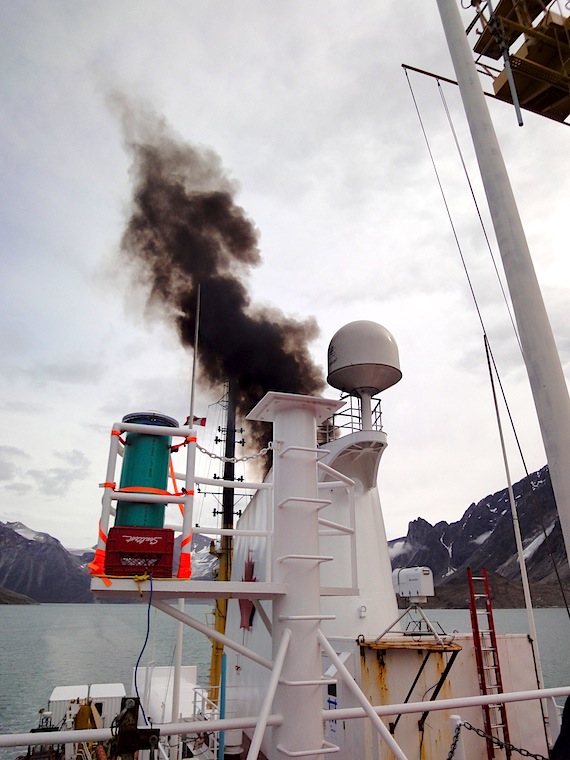Canada updates Arctic shipping rules, but still allows cheap and dirty fuel
You won’t find any mention of heavy fuel oil, or HFO, pollutants in the new Arctic Waters Pollution Prevention Act regulations that came into effect this past week.
You won’t find any mention of heavy fuel oil, or HFO, pollutants in the new Arctic Waters Pollution Prevention Act regulations that came into effect this past week.
Instead Transport Canada, in a backgrounder to the new regulations, makes a point of telling Arctic shipping operators they won’t have to spend a lot of money to comply with the new regulations.
They’ll only have to spend about $25,000 per vessel to review and align their safety procedures and $10,000 on new safety equipment, the department said.
And they won’t have to stop using cheap and dirty HFOs.

The new regulations stick to the Polar Code, developed by the International Maritime Organization and brought into force Jan. 1, 2017. The Polar Code contains only a voluntary recommendation to avoid the use of HFOs.
But HFOs remain a focus of concern, because the soot generated from exhaust produced by slow-burning HFOs and other sources has a powerful impact in the Arctic, where its black particles, which soak up and magnify heat, are believed to be responsible for at least 30 per cent of warming in the Arctic.
Research has shown that reducing soot emissions could cool the Arctic faster and more economically than any other quick fix.
When spilled in cold waters, HFOs are impossible to clean up, critics say, which is why HFO has been banned in the Antarctic since 2011.
After the draft regulations were published, the World Wildlife Fund asked that Canada’s new Arctic pollution rules include a ban on HFOs.
WWF also wants a ban on ships discharging untreated grey water and sewage into northern Canadian waters, and treated grey water and sewage near landfast or shelf ice.
The new regulations fall short of these demands.
“WWF-Canada is pleased that Transport Canada has updated the Arctic Shipping Safety and Pollution Prevention Regulations to address the unique risks present in the Arctic environment,” Megan Leslie, the WWF-Canada’s president and CEO, said in a statement to Nunatsiaq News.
“The new regulations adopted the International Maritime Organization’s Polar Code, but they did not address heavy fuel oil or grey water, which WWF-Canada urged Transport Canada to address while the regulations were being updated for the Arctic. Now that Transport Canada has taken the first step with the Polar Code, we’re hopeful attention will be paid to these two urgent environmental issues.”
In the Canada Gazette, published Jan. 10, Transport Canada said the new regulations are “non-exhaustive in their treatment of other potential safety and environmental concerns facing the Arctic,” such as the management of grey water, or mitigating the risks associated with HFO.
Transport Canada emphasized that compliance with the regulations was not expected to result in “a significant financial impact on Canadian flagged vessels operating in the Arctic.”
“Indeed, any associated costs required to be in compliance are anticipated to be low, given that these vessels are experienced in Canadian Arctic navigation,” Transport Canada said.
A switch from HFOs could add an estimated $1 million to the cost of sealift for Nunavut Eastern Arctic Shipping operations in the Kitikmeot region, the company said last October during a meeting of western Nunavut mayors.
Most vessels in the Canadian Arctic still run on HFO, although Mia Desgagnés, the Groupe Desgagnés Inc.’s newest tanker, is capable of running off three types of fuel: heavy fuel oil, distillate fuel and liquefied natural gas.
In December 2016, Canada and the United States announced a joint “phase down” of HFO from their respective Arctic regions and looked to the International Maritime Organization for regulation.
The IMO accepted their report this past July and plans to consider it further this April.
So Canada’s new regulations still focus primarily on incorporating “relevant measures now contained within the Polar Code,” such as those related to vessel design and equipment, vessel operations and crew training, which Transport Minister Marc Garneau touted in a Jan. 10 release as demonstrating “Canada’s leadership on the international stage when it comes to shipping safety and pollution prevention in the Arctic.”
Canada’s new regulations include some rules not currently contained within the adopted text of the Polar Code. These focus mainly on safety requirements for vessels that intend to operate in areas with low air temperatures, such as on-board inflatable life rafts, marine evacuation systems, life boats and rescue boats that can operate at low temperatures, the backgrounder notes.
Discharging sewage from vessels into Arctic waters is allowed by the updated regulations.
A vessel with a gross tonnage of 400 toones or more or a vessel certified to carry more than 15 persons may deposit sewage at distances ranging from between three and 12 nautical miles from an ice shelf or fast ice or, if treated, “as far as practicable from the nearest land, ice-shelf, fast ice or areas of ice concentration exceeding 1/10,” the regulations say.
As for enforcement of these pollution prevention rules, Transport Canada says it will use a graduated enforcement approach with respect to their implementation.
It says “the enforcement objective is to permit industry to take corrective actions first, especially for minor infractions, rather than to proceed immediately with issuing monetary penalties and/or summary convictions.”
“Verbal counselling or warning letters will be used when an offender commits a minor contravention, and may be accompanied by an assurance of compliance rather than immediately issuing a notice of violation,” Transport Canada said.